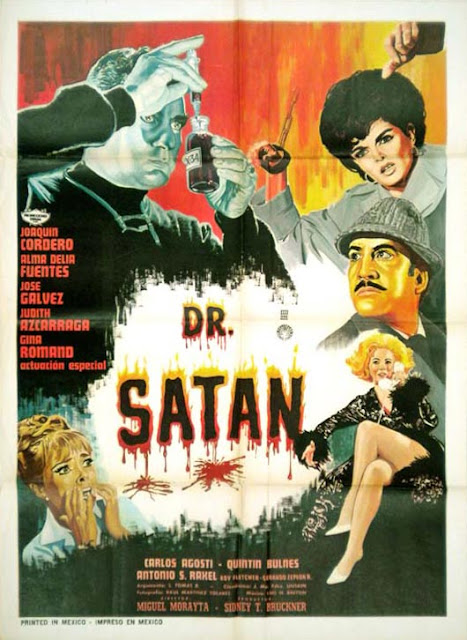PHENOMENALITY: *marvelous*
MYTHICITY: *fair*
FRYEAN MYTHOS: *adventure*
CAMPBELLIAN FUNCTION: *metaphysical, sociological* Once again, I am indebted to a YouTuber who downloaded this very obscure sixties Mex-horror for the delectation of fans. DOCTOR SATAN is a rare example of a Mexico-made supervillain who starred in his own series, even though only one other installment was produced. This black-and-white movie is, unlike a lot of south-of-the-border horror flicks of the period, remarkably tight in its melodramatic plot, not wasting any time even on comedy relief. At the helm this time is Miguel Morayta. Morayta had been directing Mexican films since the 1940s, and though I can't be sure that none of them contained metaphenomenal content, today he's largely celebrated for two atmospheric vampire films he made in the sixties, THE BLOODY VAMPIRE and THE INVASION OF THE VAMPIRES. He directed DOCTOR DEATH three years after the second of those films, but maybe Morayta didn't really like the horror genre, despite his being quite good at it. From 1967 to his retirement from the industry in 1978, I see only one other movie that clearly had fantasy-elements, and that was the comedy CAPULINA CONTRA LOS MONSTROS.
The villain, whom I'll continue to call "Satan" even though he goes by a more normative alias, initially looks like the usual Mex-horror mad scientist as he uses chemicals to revive a corpse, creating a subservient zombie servant. However, in the many atmosphere-heavy scenes that follow, it becomes evident that Satan (Joaquin Cordero) has a sorcerous relationship with the real tempter himself, addressed as "King Devil." Both times that Satan calls up the bat-winged Father of Evil, the devil-worshipping scientist has to request King Devil's leave before suborning the souls of others to make zombie servants. I found this interesting because nothing is said about King Devil having the souls of the mortal mastermind's victims because those souls sinned. King Devil thus seems less like the Christian lord of hell and more like a lord of the dead, like the Greek Hades. Oddly, the phony sounding first name Doctor Satan uses is "Plutarcho," which was almost certainly coined for its resemblance to the Roman name for Hades, "Pluto."
The bad doctor has some sort of major evil plan in the works, though he never actually says what it is. He only converses with King Devil, his zombie servants, and Luisa, the representative of a crime combine. It seems Satan needs deep pockets to fund his experiments, so he lends his zombie-making talents to the project of spreading counterfeit money throughout Mexico and the US. This involvement with Luisa's gang has a few fringe benefits-- Luisa's a sexy blonde, and she and Satan date a few times-- but the arrangement also brings the Mexican chapter of Interpol into Satan's business.
Inspector Mateos and his assistant Nora make slow progress linking Satan to the counterfeiting ring, particularly since they don't initially know they're dealing with killer zombies, immune to bullets. In one amusing scene, the police consult with Satan before they suspect him, to get him to interview a captive zombie. Satan simply exposes the zombie to salt, so that the creature dissolves, leaving the cops baffled. Since Morayta is more focused on atmosphere than action, there are only a few quick fight-scenes, and the police depend more on dogged pursuit than firepower. But I appreciated that Nora isn't the usual shrinking violet in many Mex-horror movies. When a zombie intrudes on her bedroom to abduct the young policewoman, she whips out her revolver and shoots him point blank-- which only succeeds in driving the monster off, of course. Nora and another woman also prove important in exposing Satan's involvement in the criminal racket and manage to bring Mateos and his forces to Satan's lair to bring about a rescue. Satan is captured but escapes for the sequel. I wish more of the horror-films of the period, in any country, were as tight and forbidding as DOCTOR SATAN.




No comments:
Post a Comment